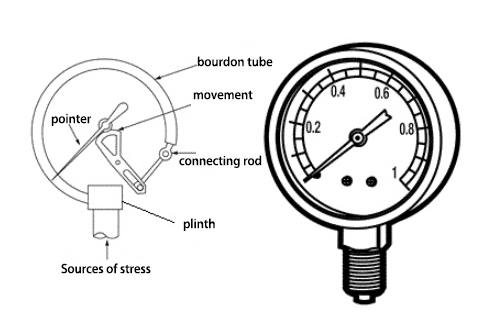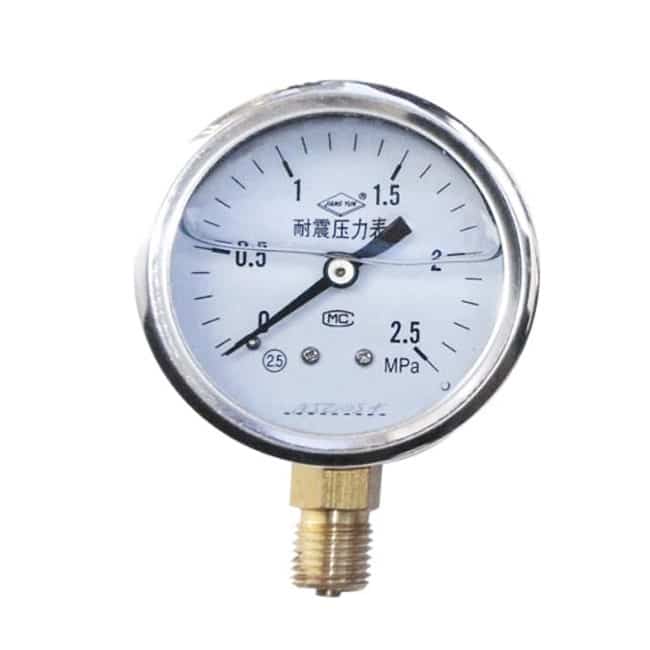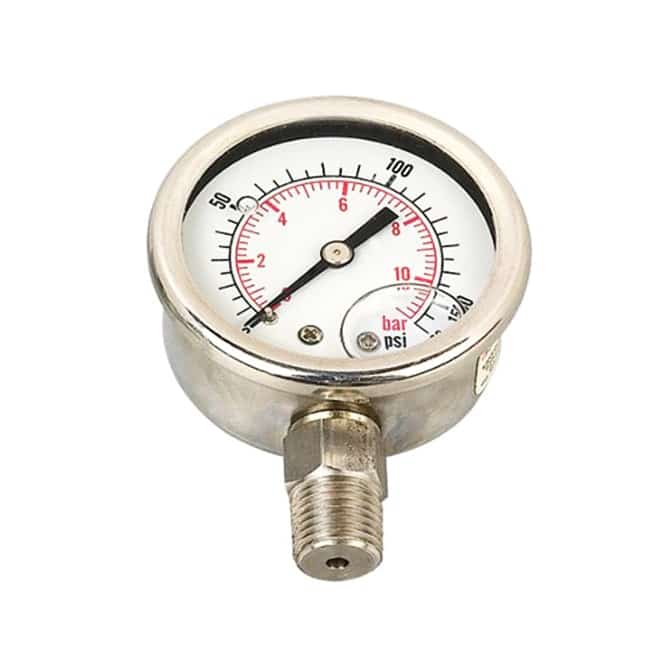A bourdon tube pressure gauge is a common pressure measurement device that utilizes the Bourdon tube principle to measure the pressure of a medium.
Principle of operation of bourdon tube pressure gauge
A bourdon tube pressure gauge is a common pressure measuring device that works on the principle of the Bourdon tube. A Bourdon tube is a metal tube that is bent into a spiral shape, where the elliptical cross-section deforms as the internal pressure changes. The working principle of the bourdon tube pressure gauge can be divided into the following steps:
- bourdon tube bending deformation: the spiral shape of the bourdon tube so that it is subject to internal pressure bending deformation. When the pressure of the medium increases, the cross-sectional area of the bourdon tube will change, resulting in bending of the tube. This deformation is due to the elastic deformation of the material of the pipe wall under the action of internal pressure.
- Transformation of the connecting mechanism: The bourdon tube is connected to a connecting mechanism (usually a rod or a thin bar), which moves accordingly when the bourdon tube undergoes a bending deformation. The movement of the connection mechanism is usually linear, but sometimes can also be converted by mechanical structure.
- Movement of the pointer: The movement of the connecting mechanism is converted into a rotational or linear movement of the pointer. The pointer is connected to the scale on the dial and indicates the corresponding pressure value when the bourdon tube is deformed. This allows the operator to determine the amount of pressure inside the system by observing the position of the pointer.

Types of bourdon tube pressure gauges
C-type bourdon tube gauges
This type of gauge uses a C-shaped bourdon tube with a C-shaped cross-section. c-type bourdon tube gauges are typically used for small to medium pressure ranges, such as low to medium pressures.
Rotating bourdon tube pressure gauge
This type of pressure gauge utilizes a spiral shaped bourdon tube with a helical cross-section. Spiral-type bourdon tube pressure gauges are usually used for high pressure ranges, such as medium to high pressure.
Spiral bourdon tube gauges
This type of gauge also utilizes a spiral shaped bourdon tube, but unlike the rotary type, it has a continuous spiral cross-section. Spiral bourdon tube gauges are typically used in higher pressure ranges, such as high pressure gas and liquid systems.
Deflected bourdon tube gauges
This type of gauge uses a spiral shaped bourdon tube, but has a deflected spiral cross-section. Coil-type bourdon tube gauges are typically used in applications that require a larger measuring range, such as high-pressure liquid and gas systems.
Which media is the bourdon tube pressure gauge suitable for?
- Gas: bourdon tube pressure gauge can be used to measure the pressure of various gases, including air, nitrogen, hydrogen, oxygen, argon and so on.
- Liquid: bourdon tube pressure gauge can also be used to measure the pressure of liquids, including water, oil, fuel, solvents, acid and alkali solutions.
- Steam: In some systems that need to monitor steam pressure, bourdon tube pressure gauge can also be used.
What is the pressure range of the bourdon tube pressure gauge?
Bourdon tube pressure gauges are available for a wide range of pressures, from a few millibars to several kilobars. The exact pressure range depends on the design and manufacture of the bourdon tube pressure gauge, as well as the requirements of the usage scenario. In general, the pressure ranges of bourdon tube pressure gauges can be categorized as follows:
- Low pressure range: Typically ranging from tens to hundreds of millibars, suitable for low pressure gas or liquid measurement scenarios, such as pressure measurement in laboratories or precision instruments.
- Medium pressure range: Typically from a few hundred millibars to several tens of bars, suitable for measuring gases, liquids or vapors in general industrial applications, e.g. in air-conditioning systems, water supply systems, process manufacturing, etc.
- High pressure range: typically from tens to thousands of bar, suitable for measuring gases or liquids at high pressures, e.g. compressed air systems, hydraulics, petrochemicals, etc.
- Ultra high pressure range: Typically ranging from thousands to hundreds of thousands of bars, suitable for measuring extremely high pressure gases or liquids, e.g. high pressure fluid pipelines, high pressure vessels, underground mines, etc.
Apure’s YJ Water Bourdon Tube Pressure Gauge has a high precision, all stainless steel construction, high immunity to interference, long term stability, and a range of up to 0 … 1,000 bar.


What is the bending angle of the bourdon tube pressure gauge?
The bourdon tube of a bourdon tube pressure gauge usually has a fixed bending angle, which is usually fixed and related to the design and manufacture of the gauge. Typical bourdon tube gauges typically have a bend angle in the range of 250 to 300 degrees, which provides sufficient sensitivity and accuracy to respond to variations in pressure conditions. Larger bend angles provide greater sensitivity, but also increase the risk of fatigue and distortion of the bourdon tube, and therefore need to be balanced and considered in the design. As a result, the most common Bourdon tube pressure gauges typically utilize a bend angle of 250 to 300 degrees.
Is there a connection between the degree of bending of a bourdon tube pressure gauge and the pressure?
The degree of bending (or bending angle) of a Bourdon tube pressure gauge does correlate with the pressure it can withstand, but not directly. The degree of bend is usually determined during the design and manufacture of a pressure gauge and is designed to take into account factors such as pressure range, material strength, and the construction and size of the Bourdon tube.
While the degree of bend is not a direct determinant of the pressure range of a pressure gauge, it does have a relationship to the performance and reliability of the gauge. A larger bending angle can provide greater sensitivity and a wider pressure range, but it may also increase the risk of fatigue and distortion of the Bourdon tube. Therefore, when designing a Bourdon tube pressure gauge, a balance and consideration needs to be made to ensure optimum performance and reliability over the required pressure range.
Summary
Bourdon tube pressure gauges play an important role in industry by monitoring pressure changes in pipelines, vessels or equipment in real time, helping to ensure that systems are functioning properly and increasing productivity.
Discover Apure, your perfect solution! In addition to our classic bourdon tube gauges, we are proud to offer the YBC Differential Digital Pressure Gauge. Apure is not only dedicated to providing a wide range of pressure measurement equipment, we also specialize in water quality monitoring. No matter what parameters you need to monitor in your water, we have a package solution for you that includes a wide range of water quality instruments and sensors. We also offer thermometers, level meters and flow meters to provide you with a more comprehensive monitoring service. Please contact us if you have any questions.
